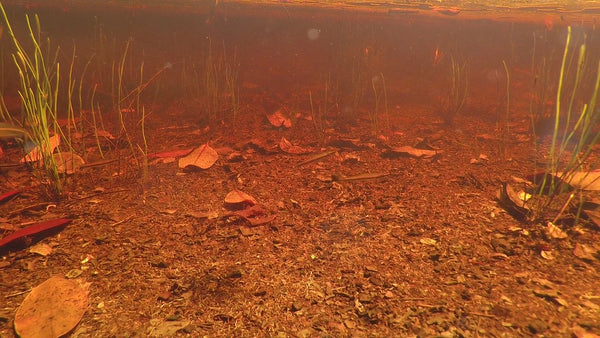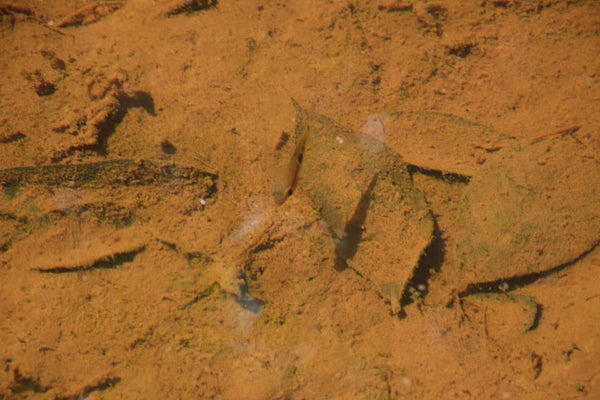- Continue Shopping
- Your Cart is Empty
From the bottom up...Thinking through a functional botanical aquarium design
As we get deeper and deeper into this botanical/blackwater world, the desire to push ourselves, learn more, and embrace the natural processes that have been sort of pushed aside by the bulk of the "mainstream" aquatic world has inspired us to do more, try new stuff, and create.

So, my next tank will have a "dirted" substrate, consisting of a mix of terrestrial and aquatic soils, a bit of fine whitish aquarium sand, and some botanical "mulch", like our "Mixed Leaf Media", and some "Fundo Tropical" mixed in for good measure. Such a substrate kind of makes sense, too, if we're trying to replicate, to some degree, an inundated forest floor.

I think I'd put a lot of thought into the substrate, not only to make it look realistic, but to take into account the "functional" aspect of providing a good base for microbial and interstitial organisms to grow and multiply...and I suppose, for some plants, too. There are some interesting planted-aquarium-oriented substrates that could be thrown into the mix, too. And what about some peat? Hmm...not sure about peat, but perhaps some dried moss of some sort?
I look at pics like this, with the fine, mud-like substrate with leaves and botanical materials mixed into the "matrix", and it makes me really think about the "functional" aspects of substrates in our botanical aquariums.

I'd like to keep the actual substrate shallow- maybe about 1"-2" (2.54-5.08 cm) max. This would facilitate easier maintenance of the substrate when needed, and avoid any excessive aerobic activity. This would be very interesting to see how a shallow substrate with materials that would otherwise "freak out" aquarists would function!
No real "vertical relief" or variation in the depth of the substrate. Just kind of flat...
Extra credit- Maybe some potted terrestrial plants, tall enough so that the leaves break the water line...
The "upper substrate" would be a significant amount of leaf litter, probably built up at least 3"-4" (7.62- 10.16cm) deep, loosely arranged, yet with full bottom coverage. In addition to the leaves (I'd be using Catappa in mixed sizes, some Magnolia, and Guava..maybe a Loquat leaf or two, for added interest), I'd be inclined to use a few dried palm frond sections scattered about, to create more visual interest and really provide that "flooded forest floor" sort of look.

And of course, I'd intersperse some other botanicals; specifically Coco Curls, "Terra Sorrindo", "Mariposa Pods", and a few "Encontro Pods"- all sort of "leaf like" in texture and appearance, yet less "transient" in nature than leaves.
For wood, I'd be inclined to go with something really "chunky", to simulate a fallen log. Perhaps a nice-sized piece of Mopani, which has the added impact of releasing a significant amount of tannin "tint" to the water (nothing wrong with that, right?). It would be cool to just have one larger piece, and allow the biocover and bits of leaves and such to accumulate on it's surfaces, much like you see in nature. The piece of wood could become the "anchor" for the leaf litter bed, and would provide a significant foraging area for all sorts of interesting fishes and invertebrates. This pic by Mike Tuccinardi always makes the gears turn in my head:

MY friend Reid Cheung has this interesting ability to make his botanical 'scapes look very "evolved", if you will, with the substrate sort of bling into the wood, to create a deep rich, "aged" look that I find very compelling and natural. A worthy goal for any blackwater/botanical-style aquarium, I think.

A refugium would be awesome in this tank, and mine would have tons of fast growing plants like floating water sprite under intense light, and a huge inoculation of Daphnia. This refugium arrangement could have the dual benefit of nutrient processing and supplemental food cultivation via the Daphnia. Maybe even some freshwater copepods, like Gammarus, Cyclops, and such, for good measure! I think the "substrate" in the refugium would be just a large quantity of "Coco Curls" and "Teardrop Pods", because a) Coco Curls impart a lot of tannins into the water and b) "Teardrop Pods" would recruit a lot of biofilm for the Daphnia and other crustaceans to feed upon.
Yesterday, my good friend Johnny Ciotti, an "Iron Aquascaper", professional photographer, and fish geek, stopped by the office to do some photo/video work, and utilized much more intense lighting for this than we normally operate on the aquarium, and it gave me a sort of unique insight into the otherwise dark world of this blackwater aquarium.
I noticed many interesting things for the first time (believe it or not) that I really liked. For example, you'd see bits of "crumbling" botanicals accumulating in little pockets here and there among the leaves. Not "detritus" in the usual sense; rather, bits of botanical debris. Stuff enriching the aquatic environment, not detracting from it. And you'd see minute sections of biofilm on leaves, and an overall "richness" to the substrate that I can't really describe. And the colors of the leaves- they're all there, and they really popped under the bright light, almost as they did on land.

And I noticed the occasional appearance of minute pieces of leaves floating in the current here and there...The water had such a tremendous tint and "consistency" (is that the right word...?) that it really looked amazingly like many of the stretches of igarapes or blackwater streams that I've seen. In fact, on numerous occasions, Johnny would pause and look at some of his pics and say something to the effect of "You just can't tell that this wasn't taken underwater in the Rio Negro." These little details would probably freak out the typical hobbyist, who has not been "indoctrinated" into the botanical-blackwater world, but we understand...
(My lousy pic, lol)
So, the point of this little stream-of consciousness narrative is that my next tank will be optimized, if you will, to really embrace the natural processes that occur when you add botanicals into the aquarium. It will be an even greater expression of "form meets function" than I've attempted in the past. The next one will optimize the process that occur natural to embrace them not only for their function and impact on the aquatic environment, but for their aesthetics, as well.

The "mental stretches" that we talk about incessantly here are still occurring for me, years into this. With each pic I see of the natural habitats we want to emulate, and every beautiful aquarium that I see come to life from our community, it's inspiring, interesting, and engaging. I'm seeing and experiencing new things, coming up with new ideas, and trying to understand and embrace the processes and aesthetics in a whole new light.
I am happy to see many of you doing the same. Evolving.
What do you have up next?
Stay inspired. Stay curious. Stay innovative.
And Stay Wet.
Scott Fellman
Tannin Aquatics
1 Response
Joni
Glad to hear that you will be trying some dirt in the next tank. Wishing you the best on this grand adventure.











Scott Fellman
Author